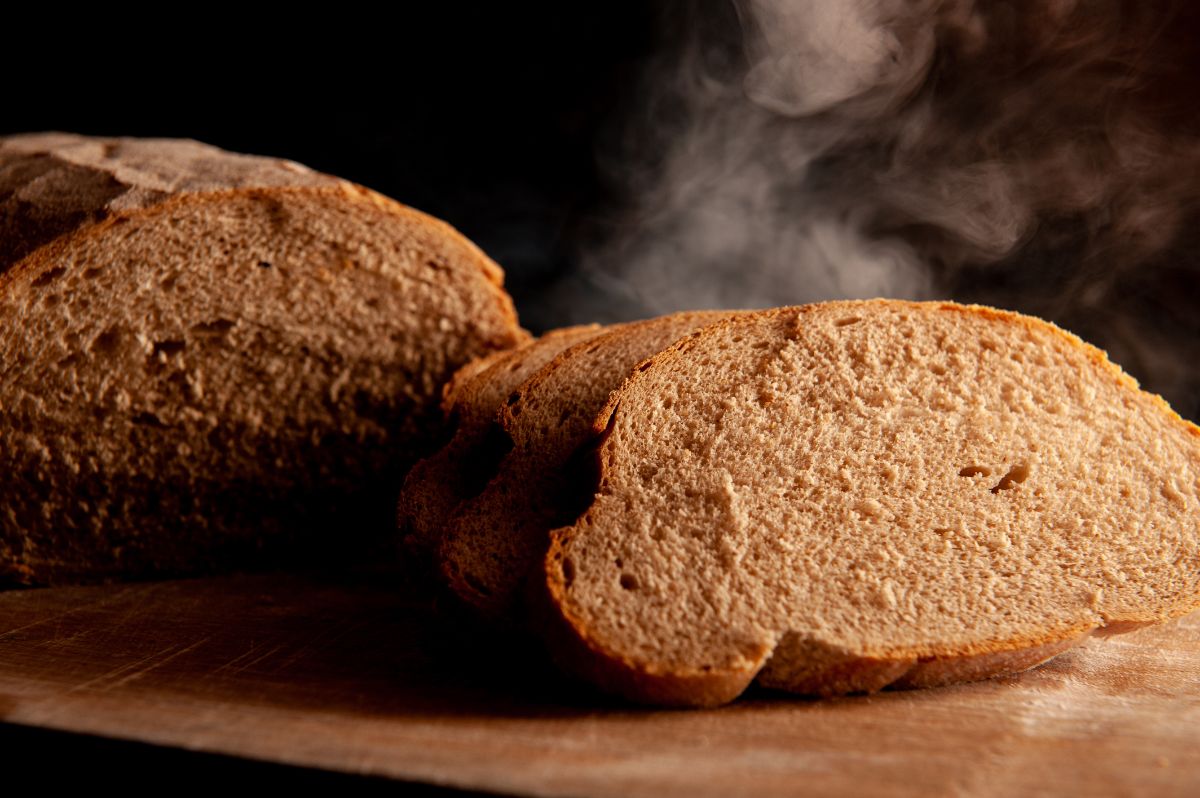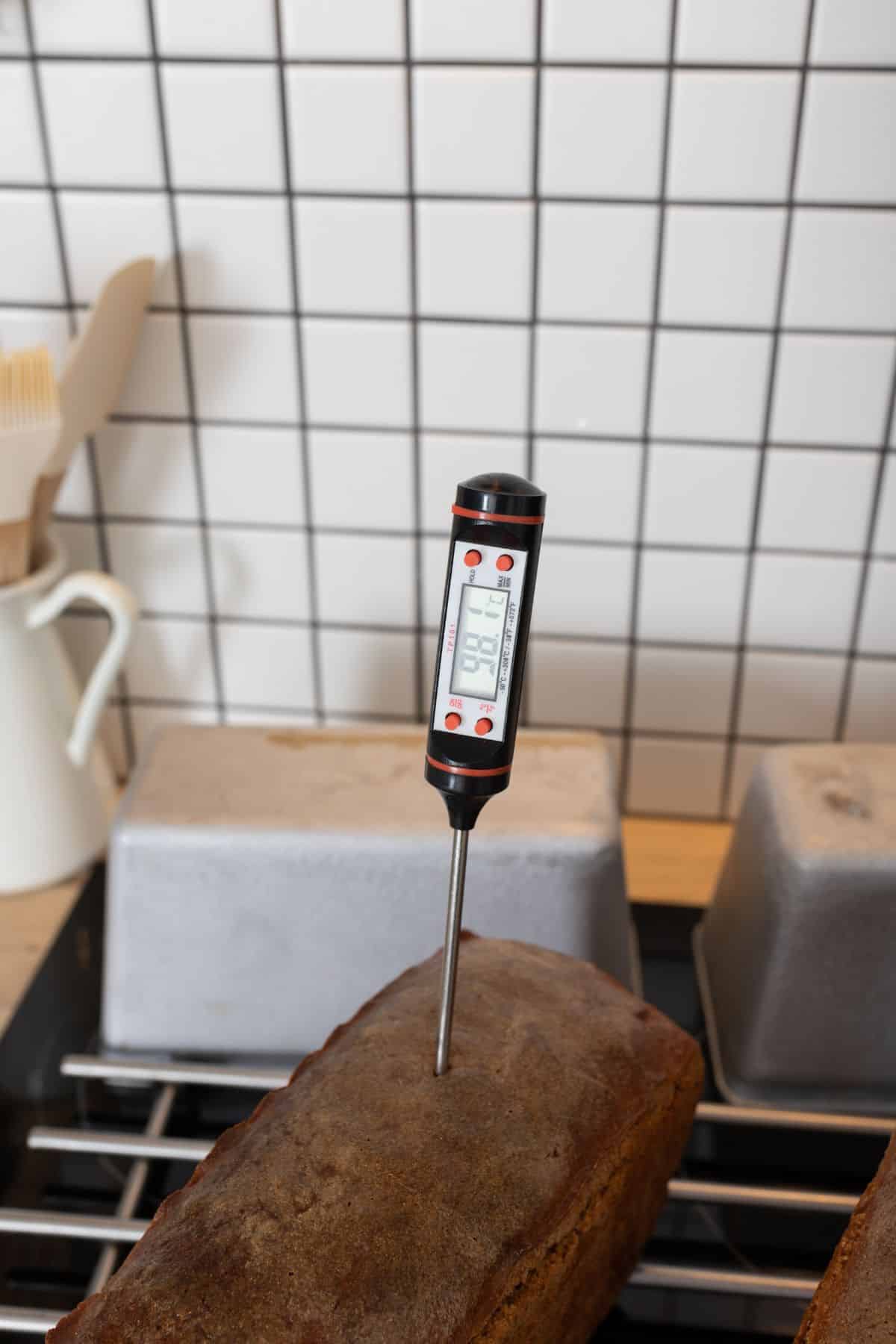If you don’t like juggling blistering hot loaves to test bread for doneness, you should take the internal temperature. This is a surefire method if you know how to interpret the results. While you don’t have to measure the temperature at every point in baking, you must follow a specific recipe.

So, what is the internal temperature of baked bread? The ideal temperature of a perfectly baked loaf is 190 degrees F. However, this depends on the type of bread you bake. Heavier bread is done at 190-200 degrees F while lean-dough loaves are done at 180-200 degrees F.
As you measure the temperature, you must factor in the appearance. A loaf of bread that is baked too little will lack the flavor because the sugars and proteins are not caramelized. Similarly, if you bake the bread for too long it will have a burnt feel.
*This article may contain affiliate links. As an Amazon Associate, I earn from qualifying purchases. Please take that into account.
- Dutch oven
- Large mixing bowl
- Measuring cups and spoons
- Bread thermometer (fancy or a budget one)
- Scoring lame
Extra (nice to have):
- Kitchen scale
- Dough scraper and bowl scraper (yes, they are different)
- Cooling rack
- Baking stone (you don’t need a dutch oven if you use this)
👉Learn how to make bread and pizza with this awesome book.
Bread’s sugars, starches, and proteins do their job when you bake at a specific temperature. Enriched bread will have varying temperatures because they contain margarine and sweeteners.
These flavor-enriching ingredients rely on temperatures of 180-190 degrees F. Sourdough and French bread are baked at a higher temperature 200-210 degrees F. If your bread has reached the optimal temperature but it’s still undercooked, you should bake for a few extra minutes.
But if you don’t get a consistent temperature every time you bake, you may want to check the temperature of your oven. In summary, quick bread is done at 200 degrees F, yeast bread at 200-210 degrees F, sourdough bread at 200-210 degrees F, and soft bread at 190 degrees F. If you hate under-baked bread you should buy a good thermometer.
How to take the internal temperature of the bread
The process of measuring the temperature in your bread is straightforward.
First, you should invest in a probe thermometer – you can pick a good one from this article. Remove the bread from the oven and insert a thermometer in the middle (underside) of the bread.
In some cases, you should shake the pan slightly to lift the bread. Hold it for a couple of minutes until the temperature stops rising. Make sure you don’t leave a hole at the top.
Once you master the technique, you’ll keep the crazy kitchen antiques at bay. Keep in mind that temperatures rise quickly towards the end of baking.
Measuring the internal temperature of yeast bread

When you sample the temperature of bread, you’ll notice something different. Those baked at 190 degrees F are softer and retain more moisture while those baked at 205 degrees are drier.
For sprouted wheat crusty bread, it’s difficult to test for doneness without a thermometer. If you rely on the crust color, you’ll face a real baking challenge.
According to professional bakers, the optimal internal temperature for crusty bread is 205 degrees F. Most baguettes are ready within 20-30 minutes, but you must test the internal temperature. They turn golden brown when the temperature is 212 degrees F.
The internal temperature of whole-grain banana, pumpkin, and Zucchini bread
Have you ever cooked banana bread only to find uncooked batter at the center? I’m sure the only choice you had is to throw it away.
The top crust may look brown, but the bread may be under-cooked. For baking enthusiasts who rely on the toothpick to test doneness, it might not work with banana bread.
If the batter has bits of zucchini or banana, this test may be unreliable. Instead of using a thin-bladed knife or a toothpick to test for doneness, you should use a thermometer.
If you believe the bread is done, stick the thermometer in the middle of the loaf. Under normal conditions, the thermometer should read 200 degrees F to 205 degrees F. The top may have a temperature of fewer than 200 degrees F because it’s exposed to room temperature.
Understanding the changes in internal temperature when baking
Baking is an interesting journey, so you should understand how temperature affects the overall outcome of your bread. At 80 degrees F, carbon dioxide is produced from yeast.
Next, the starch granules gelatinize at 140 degrees F. During this stage, a thick web of molecules is created. At 160 degrees F, gluten strands curl up to solidify the bread’s structure.
Also, the fats in the dough start to melt. At 190 degrees F, the sugars combine with protein to produce a rich flavor. These temperatures are important throughout the baking process.
Although the proteins are going to coagulate at varying temperatures, a thermometer is a handy tool if you want to test the doneness of your bread.
Controlling the internal temperature of bread during baking
While the concept of bread temperature is considered arbitrary to many, it could mean the difference between under-cooked bread and sweet-savory bread.
The generally accepted temperature in baking is 195 degrees F to 200 degrees F. Lean dough is baked at a higher temperature than rich dough.
When the temperature is too low, gluten and starch will have a low opportunity to set. When you don’t allow the bread to attain the right temperature, it will lose the crusty feel.
A variety of reactions occur for the bread to attain internal temperature. First, yeast activity helps in the production of carbon dioxide. Then, the coagulation of protein takes place.
Lastly, the browning reaction occurs as a result of sugar and starch activity. At 190 degrees F, your bread will have the desired flavor and aroma.
So, why is the internal temperature of bread important? If you find a gooey spot at the center of the dough, your bread is not ready. To eliminate any guesswork, a thermometer can help you get the right temperature.
For those who think these devices are fussy, they should be a baker’s best friend. Most sandwich loaves are enriched with sugar, milk, and eggs, so they are done at an internal temperature of 185-190 degrees F.
How does this help in your baking? Well, from a culinary perspective you can know the right temperature for your bread.
Final thoughts
Baking is more than placing the dough in the oven. Ideally, the internal temperature of the bread is an accurate measure of bread doneness.
Bread with crispier crusts and brown hues requires more than temperature as an indication of doneness – watch the clock. A temperature of 190 degrees F yields a loaf of bread that is soft and moist.
For those with a crusty interior, you should maintain the internal temperature at 205-201 degrees F. Finally, gluten-free yeast bread should bake at 205 degrees F.
Whether you’re a novice or a professional baker, you should rely on a thermometer to ensure the bread is fully baked.
